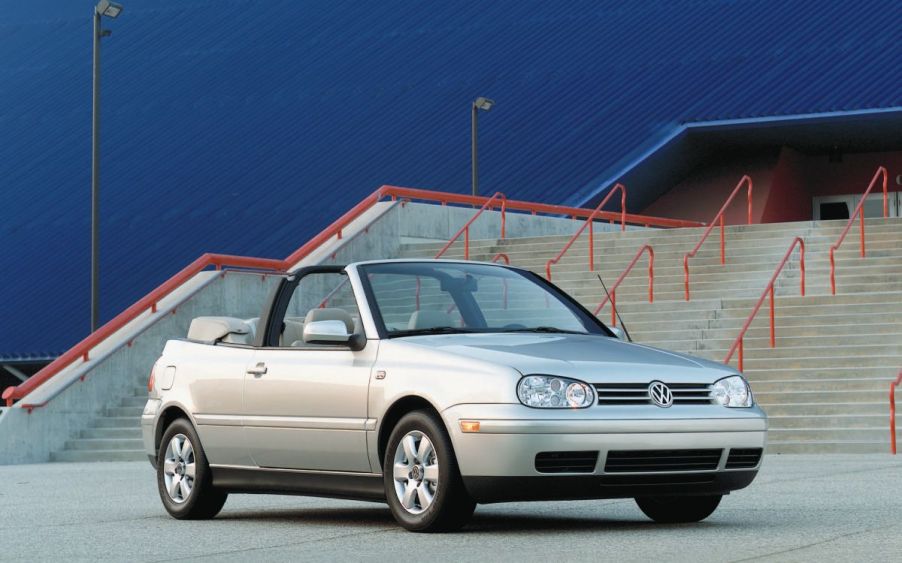
What Happened to the Volkswagen Cabrio?
Although perhaps not the company’s intended outcome, Volkswagen’s iconic Cabriolet was the one-time dream car of teenage girls everywhere. Nothing solidifies that image more than its prominent role in the 1987 romcom Can’t Buy Me Love, starring future racing enthusiast Patrick Dempsey. The Cabriolet in question belonged to Dempsey’s female love interest, but he did get to drive it to a romantic date at an airplane graveyard.
Lest you think we’re being chauvinistic, a struggling actor named Jon Hamm—later of Mad Men and Top Gun: Maverick fame—also drove a dilapidated 1981 Rabbit Convertible around Los Angeles in real life after his Toyota Corolla was impounded for too many unpaid parking tickets.
But we digress. By the mid-2000s, Volkswagen found itself with one too many convertibles in its lineup with the New Beetle and upcoming Eos, so it was the aging Cabriolet that went on the chopping block.
When did Volkswagen make the Cabrio?
By the mid-1970s, the writing was on the wall for Volkswagen’s original Beetle. A modern replacement for the ancient Beetle—in production since 1945—was sorely needed. The vehicle that filled that need was the Golf, which debuted in 1974 as the Beetle’s polar opposite—an angular, front-engine, front-wheel drive hatchback.
In the United States, the Golf was initially marketed as the Rabbit, which VW thought would convey an image of nimbleness and agility to youthful buyers of the economy car.
The one thing missing from the Golf/Rabbit compared the outgoing Beetle was a drop-top version. According to Volkswagen, “In 1976, Volkswagen wanted to design a new compact, affordable convertible built with safety in mind. The result hit the U.S. market in 1980 as the Volkswagen Rabbit Cabriolet.”
The brand claims that it was “the first car in this class to have a permanently installed roll bar” and they further gushed that “It even led to a global renaissance of convertible driving.” While the latter claim might be debatable, the Cabriolet and later Cabrio were indeed popular and logged nearly one million sales worldwide.
Even though the fixed-roof Golf/Rabbit was redesigned for 1983, the Cabriolet continued to be based on the first-generation Golf until 1993. So essentially, the hatchback and convertible were two different cars for about 10 years until both were redesigned again for 1993. In 1985, VW droppd the Golf or Rabbit moniker altogether and began calling the convertibles simply Cabriolet.
The same dynamic played out again in the late ’90s when the Golf was redesigned yet again, but the convertible—now called just Cabrio—was not. In 2002, Volkswagen finally killed the Cabrio altogether. Between the Eos with its slick retractable hardtop on the way and the New Beetle convertible, the Cabrio was simply redundant and the most dated of the bunch.
Was the Volkswagen Cabrio a good car?
The Cabriolet’s roll bar that Volkswagen is so proud of really does lend considerable torsional rigidity to the chassis. Not to mention that it’s an ideal place to anchor shoulder-height seat belts and gives the raised convertible top a place to rest instead of buffeting in the wind.
So while the Cabriolet was a safe car, it wasn’t a very quick one. Horsepower grew slightly over the years, but the 1979 to 1993 cars peaked with 94 horsepower from a small four-cylinder. The Cabrio wasn’t much better, with a maximum of 115 horsepower. Sadly, there was never a hot GTI version like the Rabbit/Golf hatchback.
While zero to 60 MPH took a leisurely 10 to 11 seconds, depending on year, all Cabriolets were reportedly fun to drive—especially with a manual transmission—and delivered decent fuel economy for their time
Can you still find one today?
According to the classic.com, which aggregates information from automotive auction sites like Bring a Trailer, a total of 42 of the original 1979-1993 Cabriolets sold in the past 12 months at an average price of $12,524. For the later Mk. 3 generation cars (the Cabrio skips the Mk. 2), the average price was considerably lower at $6,542 among the 11 examples sold in the past 12 months.
Do keep in mind that the Cabrio isn’t like a 1969 Dodge Charger that everyone knows is valuable and collectible. We’re betting there are still many sellers treating their Cabrios like just another used car, not an under-the-radar classic. A quick search of my local (Colorado) Facebook Marketplace turned up over a dozen Cabrios, including the more valuable earlier cars, all priced between $1,000 and $6,000.
Now that we think about it, maybe there’s an opportunity to flip some of these Facebook Cabrios for fun and profit? Just don’t let anyone else in on the secret.



